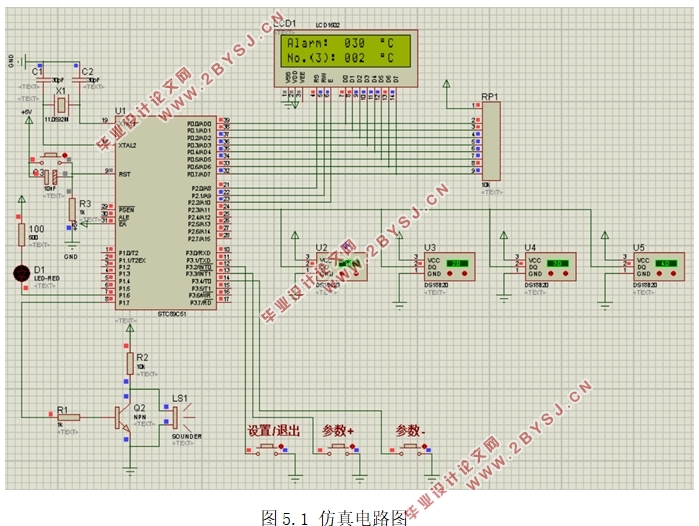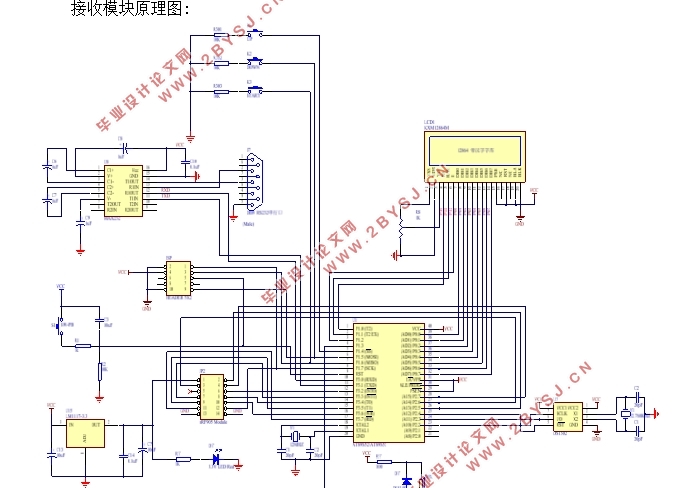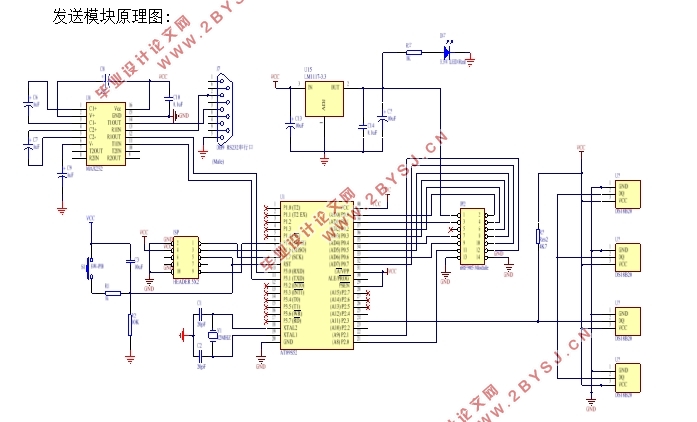单片机无线多路温度采集系统设计(附仿真程序)
无需注册登录,支付后按照提示操作即可获取该资料.
单片机无线多路温度采集系统设计(附仿真程序)(任务书,开题报告,外文翻译,论文9000字,仿真程序,答辩PPT)
摘要
伴随着时代的不断进步和发展,在我们生活、工作的各个领域已经开始普遍应用了单片机和传感器技术。在传统的测温方法中,我们基本都是使用热敏电阻来作为温度传感器,这种测温方法的不足之处在于测量温度的准确率较低,数据不够可靠。而DS18B20温度传感器则在很大程度上改善了这些问题,首先它是一种数字式的温度计,它的温度感应装置是由数字温度传感器构成,其次它的连接方式是用户友好的单总线类型,这让我们的电路设计过程有了巨大的简化。在设计中,我们还添加了nRF905无线传输模块,实现了一定的温度数据传输距离,使设计模块能够进行远程检测和控制。这次设计所采用的主控制器是具有良好性能的AT89S52单片机,它相比于AT89C51单片机多了一个定时/计数器,有更多的RAM和ROM 空间,更能满足大多数设计的需求。
本次设计的模块具有较强的参考价值,它的测量精度较高,并且扩展起来非常方便,能够完成在一定距离内的无线检测,在各种大型工厂等场合都能被广泛使用。
关键词:DS18B20;AT89S52;nRF905
Abstract
With the continuous progress and development of the era, we have begun to universally apply single-chip microcomputer and sensor technology in all areas of our lives and work. In the traditional temperature measurement method, we basically use a thermistor as a temperature sensor. The disadvantage of this temperature measurement method is that the accuracy of the measurement temperature is low, and the data is not reliable enough. The DS18B20 temperature sensor has greatly improved these problems. First of all, it is a digital thermometer whose temperature sensing device consists of a digital temperature sensor. Secondly, its connection method is a user-friendly single-bus type. This has greatly simplified our circuit design process. In the design, we also added the nRF905 wireless transmission module to achieve a certain temperature data transmission distance, so that the design module can be remotely detected and controlled. The main controller used in this design is the AT89S52 microcontroller with good performance. Compared with the AT89C51 microcontroller, it has a timer/counter, more RAM and ROM space, and can meet the needs of most designs.
The module designed this time has strong reference value. It has high measurement accuracy and is very convenient for expansion. It can complete wireless detection within a certain distance and can be widely used in various large factories and other occasions.
Key Words:DS18B20;AT89S52;nRF905
1.3 设计内容及要求
我的这次设计是要求完成一个多路温度采集系统,它以单片机为核心,应能完成多点温度采集、无线传输、显示、报警等功能。它使用AT89S52微控制器来实现主要的控制功能,使用DS18B20来采集温度数据,并使用nRF905发送和接收数据,再以LCD液晶屏做最后的显示输出,此外还要加入蜂鸣器、LED灯构成声光报警电路。
2.1 设计方案描述
本次设计一共可分为两个大部分,其中第一个部分是温度的采集与发送,它包括DS18B20温度采集、AT89S52总体控制、nRF905发送数据,在DS18B20的使用上主要是注意区分它的序列码来识别不同传感器和进行合适的温度转换,在AT89S52的使用上主要是完成它的最小系统以及注意各寄存器的使用,在nRF905的使用上主要是注意它工作模式的设置以及各引脚功能的定义;第二个部分是数据的接收和显示,它包括nRF905接收数据、AT89S52总体控制、LCD1602显示数据、声光报警电路,其中AT89S52和nRF905的注意事项与前面相同,在LCD1602的使用上主要是注意它显示位置的定义以及显示的数据表示,声光报警电路主要是通过键盘来完成预定温度报警值的设置。这样就可以通过SPI协议来完成整个设计的无线传输。




目录
摘要 I
第1章 绪论 1
1.1 研究背景与意义 1
1.2 研究目的及应用 1
1.3 设计内容及要求 1
第2章 设计方案论证与选择 2
2.1 设计方案描述 2
2.2 设计框图 2
2.3 系统硬件结构 3
第3章 系统硬件电路设计 4
3.1 温度采集模块设计 4
3.1.1 DS18B20简介 4
3.1.2 电路设计 4
3.2 无线传输模块设计 5
3.2.1 nRF905简介 5
3.2.2 电路设计 6
3.3 显示模块设计 7
3.3.1 LCD1602简介 7
表3.4 LCD液晶屏控制指令 9
3.3.2 电路设计 9
3.4 单片机最小系统设计 10
3.4.1 AT89S52简介 10
3.4.2 外围电路设计 11
3.5 报警电路设计 13
3.5.1 报警电路 13
3.5.2 键盘控制电路 13
第4章 系统软件设计 14
4.1 程序设计思路 14
4.2 程序流程图 14
4.2.1 温度采集流程图 14
4.2.2 发送流程图 15
第5章 系统仿真与调试 18
5.1 仿真电路图 18
5.2 仿真设置 18
5.3 调试与分析 19
第6章 结论 20
参考文献 21
附录A 22
附录B 源代码 24
致谢 60
